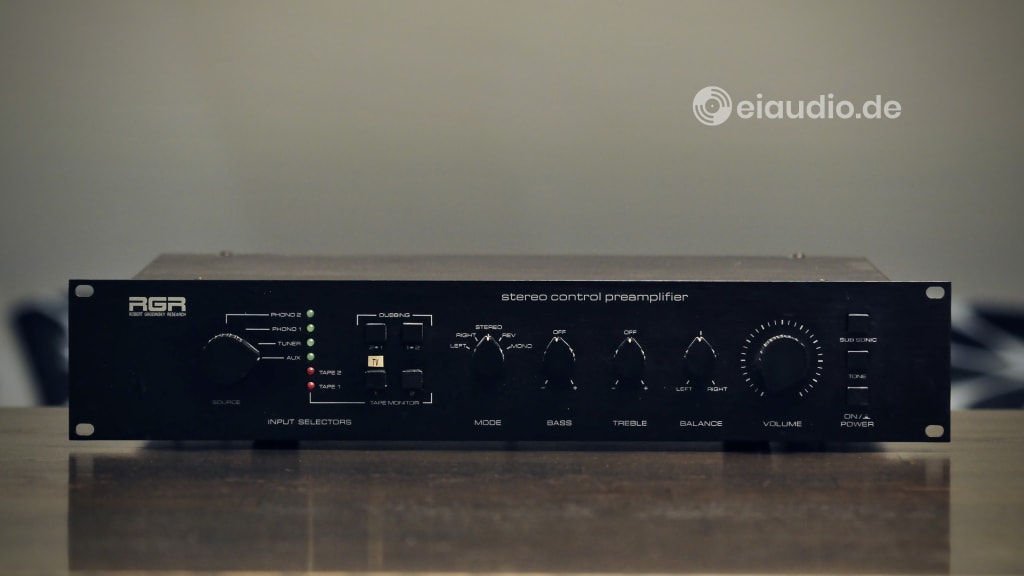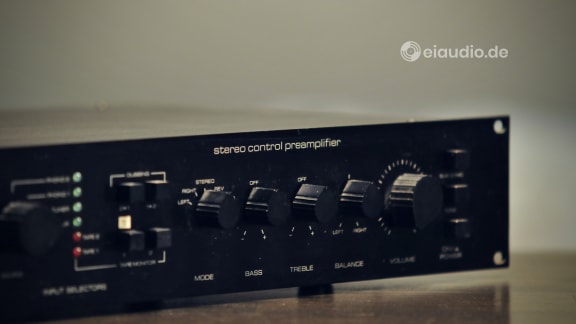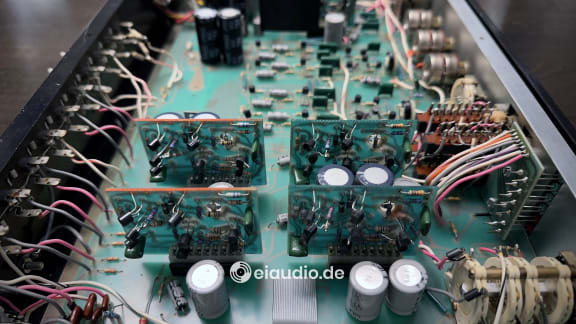Robert Grodinsky Research RGR Model 4
Published: 14/01/2023
Manufacturing date: 1980
Author: Karsten Hein
Category: Gear & Review
Tag(s): Pre-Amplifiers
The Model 4 was the successor of the Model 3 preamplifier and was built by the American audio engineer and former Audio Research (ARC) developer Robert Grodinsky in his newly founded company. The Robert Grodinsky Research (RGR) was based in Lincolnwood, Illinois, and built a select range of High-End audio equipment that included its own brand pre and power amplifiers, as well as processors for other companies, e.g., Audio Research, Koss, and Pioneer). Robert Grodinsky himself also offered tuning and upgrade solutions to owners of Audio Research equipment.
The Model 4 came in various sub-versions that mostly differed in the design and functions of the phono stage. The basic model came with two phono inputs on which the capacitance could be independently adjusted in three steps: 30, 130, 360 pF. It was designed in the early 1980s, when phono was still the most likely source for High-End audio listening. Having two adjustable inputs would have made the Model 4 a welcome feature for vinyl heads of the time. Early versions offered moving magnet (MM) inputs, whereas the revised Model 4-1HG featured inputs for MM and moving coil (MC) cartridges.
The renowned HiFi magazine The Absolute Sound made Robert Grodinsky Research famous by discussing the merits and shortcomings of the Model 4 at length. While the soundstage was deep and wide with an open and holographic representation of music, the Model 4 was also a departure from the slightly darker and fuller American sound. As such, the Model 4 was more similar to the High End sound familiar from Germany and Japan. The phono stage was described as outstanding in the given price range. As Robert Grodinsky continued to make adjustments to the Model 4 design throughout its 2-year history, it will be difficult to find two preamps that sound identical.
At 6.5 kg, the Model 4 was of surprisingly heavy build for a preamplifier. All controls were made of metal with the knobs being L-shaped. Volume was set via stepped attenuator. The active signal source was indicated via warm-glowing LED light. There were two buttons to set the tape dubbing direction and two buttons to activate the tape monitors which could also be used as pass-through to other components. A versatile Mode-selector allowed the user to play the left or right channel signal independently, to reverse channels, or to down-mix the output signal to mono. For those working with HiFi or PA equipment professionally, features like these could come in very handy, e.g., when trying to identify and correct an electronic or acoustic issue.
The RGR Model 4 also included knobs to adjust bass, treble, and balance to the room, as well as a subsonic filter for eliminating rumble and feedback that would typically come from playing records. It was surely a concession to the High-End purist and not the PA user that the tone controls could be fully discharged from the signal path at the touch of a button. All buttons and switches gave great haptic feedback, except for the small switches at the back of the unit that were used to adjust phono capacitance and that were sometimes described as imprecise and below expectations. Another such quirk from today’s perspective was the unusually narrow gab between the cinch/RCA sockets that allowed for standard diameter cinch/RCA plugs only. However, with the cinch terminal being bolted in with studs and the internal free wiring, it would be an easy task to upgrade the terminal to the modern standard.
The Model 4 also featured an external processor loop, a field that Robert Grodinsky was an expert in. A look inside of the unit revealed a large motherboard on which smaller modules were vertically stacked. These modules functioned as discrete operating amps and were used to produce signal gain. Perhaps it is this particular design that led to the Model 4’s non-fatiguing and airy sound that provides good sound-staging, imaging and bass. There was also a Model 5 power amplifier to accompany the preamplifier which has meanwhile become quite rare on the market. While the early Model 4 was sometimes criticised for its build quality, particularly the quality of its soldering, the Model 5 amplifier was seemed to have been under better supervision right from the start.
Robert Grodinsky Research closed its doors in the early eighties only to resurface under the name RG Dynamics shortly after. It is said that Robert Grodinsky was also the driving force behind a later company by the name of State Technology Research.
Specifications
- Type: Solid state stereo preamplifier
- Version: Mark I (without MC connectivity)
- Phono inputs: 2x moving magnet (MM)
- Phono adjustments: 30, 130, 360 pF capacitance
- Phono equalisation: RIAA +/= 0.1 dB
- Line inputs: 2x Auxiliary, 2x Monitor
- Tape record outputs: 2x cinch/RCA
- Rated output voltage: > 2.0 V
- Harmonic distortion (1 kHz): < 0.005%
- Intermodulation noise: 0.006%
- Power bandwidth: 0.5 Hz to 300 kHz
- Frequency response: 20 Hz to 20 kHz (+/- 0.05 dB)
- Signal-to-noise ratio: Phono MM/MC: > 80 dB
- Signal outputs to amplifier: 4x line/RCA
- Tone controls: Bass (20 Hz) +/-12 dB, Treble (15 kHz) +/-12 dB
- Dimensions: (W) 484mm x (H) 95mm x (D) 300mm
- Weight: 6.5 kilograms
- Country of manufacture: USA
- Year(s): 1980-1982






